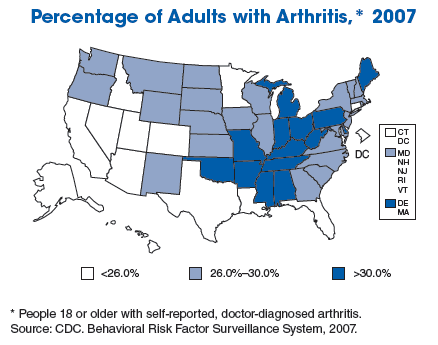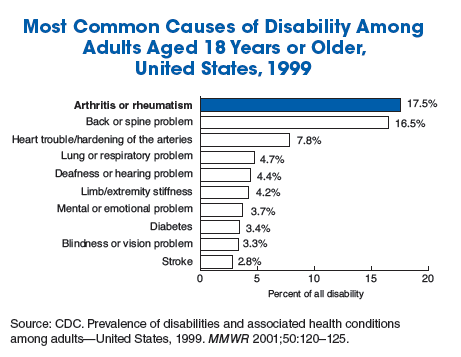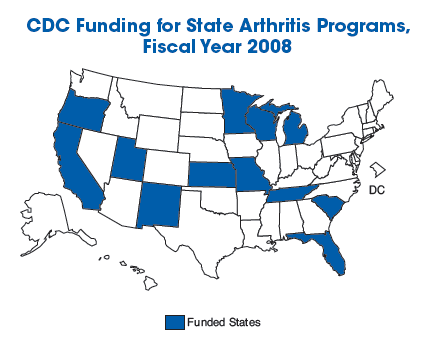 |
|
 |
 |
 |
Preventing Arthritis Pain and Disability
The Reality
- Over 46 million Americans—about one in every five adults—have
arthritis. As the population ages, these numbers are projected to
increase dramatically.
- Arthritis is more common among older adults, but it also affects
children and young adults. In fact, nearly two thirds of people with
arthritis are younger than 65.
- Arthritis is the most common cause of disability among U.S. adults.
It limits everyday activities for 19 million Americans.
- Early and aggressive management of arthritis can reduce
complications and delay costly procedures like joint replacements.
- Among adults with doctor-diagnosed arthritis, approximately one
third report having a work limitation attributed to arthritis.
- Self-management education programs that have been shown to reduce
pain and disability are not geographically available to many people with
arthritis who could benefit from them.
The Cost of Arthritis
- Each year arthritis is estimated to cost $81 billion for medical
costs and an additional $47 billion in lost wages (in 2003 dollars).
- Arthritis is responsible for 750,000 hospitalizations and 36 million
outpatient visits every year.
- As the U.S. population ages, arthritis-related costs are likely to
soar.

(A
text
version of this graphic is also available.)
Arthritis Control: A Good Investment
Early diagnosis and appropriate management of arthritis can help people
with arthritis function better, stay productive, and have lower health
care costs.
- One study estimated that implementing the Arthritis Self-Help Course
among just 10,000 people with arthritis can result in a net savings of
more than $2.5 million over 4 years.
- Achieving a healthy weight lowers a person’s risk for developing
osteoarthritis in the knees, slows progression in people who already
have the disease, and delays costly knee replacement surgery.
- Moderate physical activity relieves arthritis pain and stiffness and
can improve mental health.

(A
text
version of this graphic is also available.)
Effective Strategies and Promising Approaches
- The Arthritis Self-Help Course, developed at Stanford University, is
a 6-week course that teaches people how to manage their arthritis and
lessen its effects. In one study, arthritis pain declined by 20% and
costly physician visits were reduced by 40% among people who completed
the course. However, courses are not offered in all areas of the United
States. Making the Arthritis Self-Help Course and programs such as the
Chronic Disease Self-Management Program, which addresses arthritis along
with other chronic diseases, a routine part of health care for people
with arthritis should help reduce arthritis-related pain and health care
costs.
- Increasing public awareness about the importance of early diagnosis
should increase appropriate management for arthritis.
- Getting the message out about the benefits of healthy weight and
moderate physical activity can help people with arthritis.
Hope for the Future
CDC is working with the Arthritis Foundation and other partners to
improve quality-of-life for adults with arthritis and to change people’s
knowledge, attitudes, and behaviors related to self-management.
The National Arthritis Action Plan: A Public Health Strategy was
developed by CDC, the Arthritis Foundation, the Association of State and
Territorial Health Officials, and 90 other organizations to address the
growing problem of arthritis. It provides a blueprint for reducing pain,
activity limitations, and disability among people with arthritis, as well as
for preventing certain types of arthritis. By implementing the goals of the
action plan, CDC and its partners are moving toward achieving the first-ever
arthritis-related national objectives outlined in Healthy People 2010.

(A
text
version of this graphic is also available.)
State Program in Action
 Minnesota:
New Partnership Increases Participation in Education and Minnesota:
New Partnership Increases Participation in Education and
Exercise Programs Across the State
More than 50% of Minnesota’s older adults (aged 50 years and
older) have been diagnosed by a doctor or other health professional
with a form of arthritis. To address this burden, the state’s
Arthritis Program, with support from CDC, initiated a new
partnership with the Elderberry Institute’s Living at Home Block
Nurse Program to increase participation in self-management education
and exercise programs and expand intervention programs across the
state. The Elderberry Institute’s Living at Home Block Nurse Program
is a community service program that helps older adults remain in
their homes as long as possible.
Through this partnership, the Minnesota Arthritis Program has
made remarkable progress in dramatically increasing the numbers of
program participants, leaders, and exercise program instructors.
Geographic reach of programs has also widened. In 2005, only 14 of
the state’s 87 counties had arthritis intervention program leaders;
by 2006, there were program leaders in 50 counties.
As the aging population rapidly increases, the Minnesota
Arthritis Program has adopted a systems approach to expand
intervention services to those most in need. By embedding their
intervention activities in a program that serves similar target
populations and shares overlapping goals, the Arthritis Program has
effectively linked more people with programs and expanded the reach
of services.
As states and CDC focus on meeting Healthy People 2010
goals related to improving the quality of lives for people living
with arthritis, partnering with existing programs such as the Block
Nurse Program is an important strategy for reducing health care
costs and the burden of arthritis. |
For more information and references supporting these facts, visit
www.cdc.gov/nccdphp. For
additional copies of this document, E-mail
cdcinfo@cdc.gov.
Department of
Health and Human Services
Centers for Disease Control and Prevention |
 |
Page last reviewed: September 22, 2008
Page last modified: September 22, 2008
Content source: National Center for
Chronic Disease Prevention and Health Promotion
|
 |